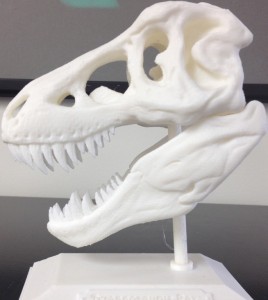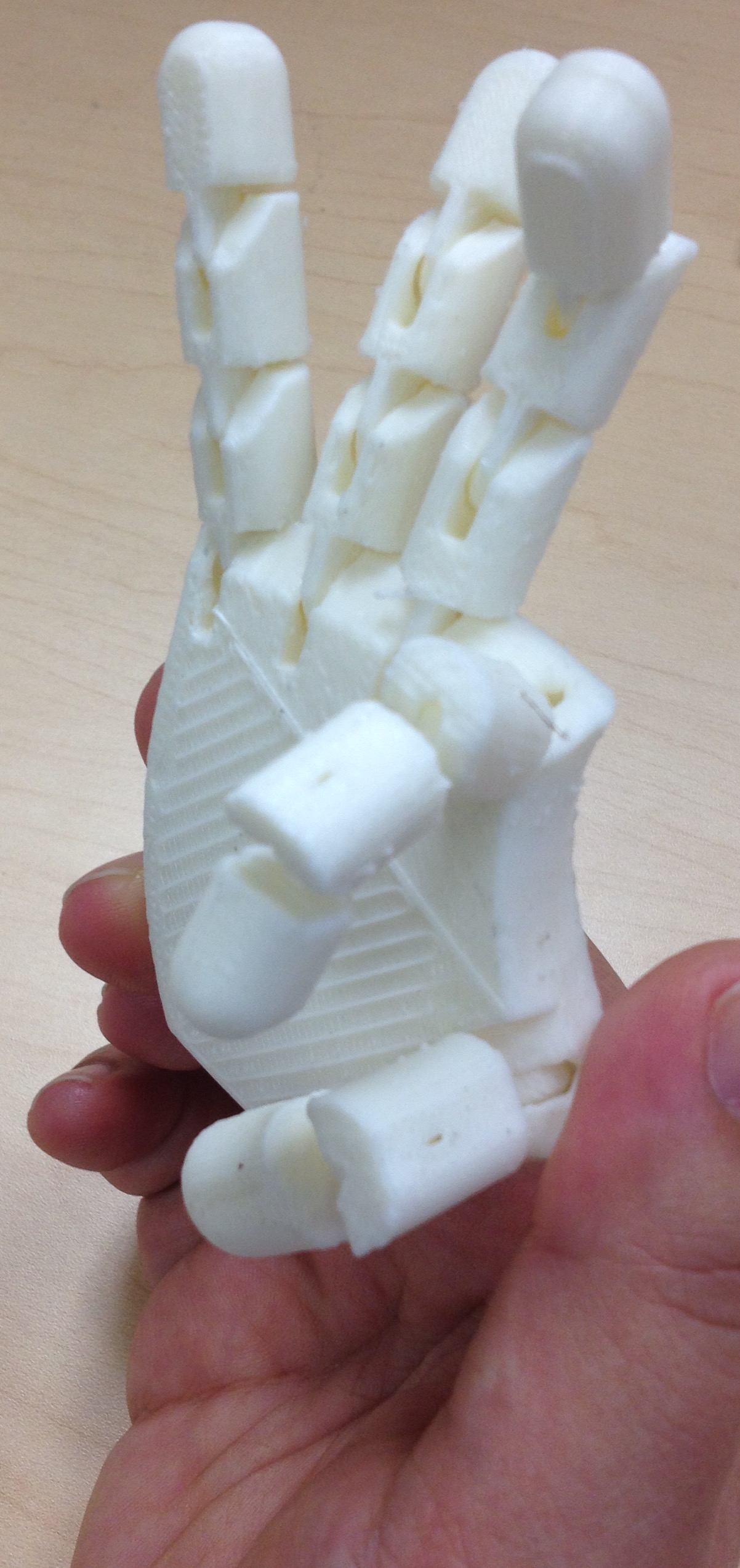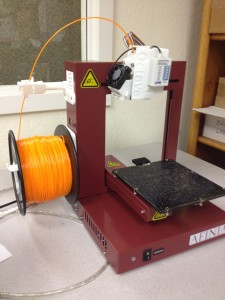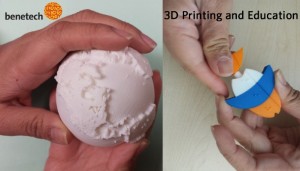 3D Printing, Tactiles and Haptics
3D Printing, Tactiles and Haptics
New technologies for creating tactiles and tactile experiences offer revolutionary ways of conveying spatial information. The work described below represents the DIAGRAM Center’s ongoing exploration of these technologies, including 3D printing and haptics.
3D Printing
3D models add another dimension of depth to traditional images and open doors for multimodal learning. With revolutionary implications for education, medicine, and more, 3D printing offers a low-cost alternative to creating 3D models that increases opportunities for customization and experimentation. The DIAGRAM Center is exploring 3D printing technology as a way to increase access to curriculum and learning. For students, 3D-printed models can offer better ways of understanding spatial concepts for things that would otherwise be too large, too small, too valuable/rare, or too dangerous to hand to a student. They can be customized, created by non-specialists in accessibility, and shared with all students in a classroom.

Printing of Braille with 3D printers
The introduction of 3D printers in education has created a new opportunity for people to create tactile materials for students who are blind. This document seeks to inform object creators about the best way to add braille to 3D objects.
Based on testing with braille reading users and many different types of printers (Makerbot, MakerGear, TypeA, Ultimaker, and more) we found that ‘vertical braille’ is the best method of printing braille with a 3D printer (see below). Testing was conducted by the Lighthouse for the Blind and Visually Impaired in San Francisco, Texas School for the Blind and Visually Impaired, DIAGRAM Symposium on 3D Printing.
3D Printing for Accessible Materials in Schools

In 2013, researcher and TVI (Teacher of the Visually Impaired), Yue-Ting Siu (UC Berkeley & San Francisco State University) conducted a one-year research project about 3D printing in education. The main advantages of using 3D printing are: bringing imagined creations to life, ability to customize devices, enhancing the learning of all students in a classroom, and use of the technology by anyone to create an accessible environment. While there are still some challenges, Ting provided some recommendations that include:
- Collaboration between technology, computer programming, general education teachers, and community supports
- Simplify implementation of 3D printing to the acquisition and maintenance of a 3D printer as the technology gets more affordable and usable
- Cultivate open access repositories that offer curated selections of files for easy download and printing as aligned with academic curricula
- Provide training to promote understanding of 3D printing’s capabilities and how it fits into the larger set of tools for providing accessible materials for students with visual impairments.
Read the full report here (Word document): 3D Printing for Accessible Materials in Schools (final version). See also a closed-caption recording of Ting’s DIAGRAM webinar on this topic, along with handouts and a written summary of the Q & A for the webinar: 3D Printing for Accessible Educational Materials.
SVG and 3D Printing Report

In the DIAGRAM-sponsored report “Assessments of Raster-to-Vector (SVG) Conversion software and 3D Printers for Tactile Graphics” National Braille Press assesses SVG software to find a version that is affordable, and easy to use for publishers and individual content providers. Beyond the DIAGRAM Center’s interest in SVGs for publishers, SVGs also provide a number of digital conversion options for tactile graphics like 3D printed objects, when description alone is inadequate. 3D printers may provide one method for these solutions that can provide perfect proportioning, detailed resolution, and reduce the labor time required compared to the collage methods of creating tactile graphics, especially with complex images.
Stanford Student Research Paper: “3D-Printed Teaching Aids for Students with Visual Impairments”

In the spring of 2014, three Stanford University undergraduates became interested in the work Benetech and DIAGRAM were doing to support accessibility in STEM for students with visual impairments. They set out to first determine what instruments already existed for these students and evaluate the need for 3D printed education tools. They then worked to address the lack of learning aids by designing and printing a variety of objects to be used in STEM classrooms. The results of their work indicated that 3D printed models fill a hole in available learning aids for visually impaired students, but determined it wasn’t feasible for them to design and print individual objects. They hope to work with Benetech and other members of the assistive technology community to build a repository of 3D designs that can be standardized for large scale general use in classrooms.
3D Printing National Forum
In October 2014, with numerous DIAGRAM community members joining, Benetech kicked off a 3D Printing for Accessible Education grant from the Institute of Museum and Library Sciences. Our deliverables include a National Forum to discuss topics and issues around 3D printing in education, a quick-start guide for 3D printing and a collection of STEM objects available for educators. We hope that our work will contribute to the field of accessible tactile objects for education. On June 17-19, 2015, we conducted a forum that brought together museums, libraries, educators, end users, technologists, and publishers to discuss the implications of 3D printing technology for education. Hear the presentation from the post-forum recap webinar (or download the slides from the recap webinar here: 3D Forum Recap Webinar 8415 (NN)) to learn more about the outcomes of the forum.
For more general information about 3D printing and education see:
- Exciting Developments in Uses of 3D Printing in Education
- 3D Printing Industry (Education)
- 3D Printers in the Classroom
- 3D printers in schools: uses in the curriculum
- 3D printing in schools: The next industrial revolution?
- Horizon Report
For more information about any of the DIAGRAM 3D printing projects or to contribute to our growing collection of research on 3D printing for education, please email 3D(at)benetech(dot)org.
Tactile Graphics
Decision Tree
Developed by Touch Graphics, Inc., the Decision Tree (report in Word) is a tool for choosing which print images need tactiles and which need descriptions. A digital decision tree allows the creation of tools that will expedite the work of making textbooks accessible by allowing non-specialists to make good decisions about which images need what kind of treatment to make them accessible. The tool was found to be a successful method for novices to categorize images (mean 66% correct). Future improvements to the tool’s success will come with better understanding and agreement among experts as to whether certain images need verbal or tactile treatment. The open-source image sorting tool was built using Lime Survey. The related survey questions and the xml are freely available. A flow chart is also available (Word version here) that shows how the decision process was captured in the sorting rubric.
Tactile Graphics with a Voice
The Tactile Graphics Project at the University of Washington has created the TGV (Tactile Graphics with a Voice), a QR-code reading app that allows text within images to be read and voiced by a mobile device such as an iPhone or Android phone. For those who are interested in creating tactile graphics that include QR-codes for embedded text in images, there is a revised Tactile Graphics Assistant Manual (PDF version here) that includes information about how to include QR-codes. The TGV Design Document is available for boththe iOS (PDF version) and for the Android (PDF version). The open source code is available for both the iOS version and the Android version of TGV as well. See the published paper about this work, which won Best Student Paper at the October 2014 ACM SIGACCESS conference on computers and accessibility.
Webinar: Tactile Graphics with a Voice
February 24, 2015
Presented by Richard Ladner, University of Washington
- Download the PowerPoint slide deck
- Download written summary of Webinar Q & A (Word document) Includes questions and answers we didn’t have time to address during the webinar
- Link to a closed-caption recording of the webinar (60 minutes): http://youtu.be/ZsF_jy4S4wc
Imageshare
Developed by the DIAGRAM Center, Imageshare is a shared, open source platform for educators and consumers to explore and find alternative resources (modalities) related to key STEM concepts. As more accessible alternatives for images, such as tactile graphics and 3D object are produced, the benefit of having a centralized location where contributors and consumers can reference and discover accessible content also increases. Imageshare is that centralized collection that’s curated for accessibility. It not only eliminates redundancies within and across organizations, but also allows sharing of costly, time-intensive, and limited resources involved in the production of alternative content.
Prior to the adoption of the current name, “Imageshare,” this platform was also referred to as the Registry-Repository of Accessible Images (RRAI) and the Accessible Image Repository-Registry (AIRR).
Haptics
Integrating Haptic Feedback for Image-based STEM Content within HTML and eTextBooks
-Mark Hakkinen, ETS
Summary:
Haptic technology, already present on some tablets and smart phones, is emerging as an innovative way to augment visual information with effects such as vibration or “feelable” textures. The implications for accessibility are exciting and this project explored using vibrotactile feedback to augment visual information in EPUB and HTML content. A sample EPUB with haptic enabled SVG shapes was developed and is available for download. Additionally, instructions and source code for adding haptic effects to EPUB and HTML content is provided. Finally usability issues with haptic interfaces are discussed along with the results from a usability study with students with visual impairments.
Introduction:
Consumer tablet devices, such as the Apple iPad and Google Android products, are making significant inroads in education as a platform for delivering eBooks, instructional material, and assessments. Accessibility of the devices, and the content presented using them is an important consideration, especially for students with visual impairments, where access to graphical and spatially presented information essential to the study of science, technology, engineering, and mathematics (STEM) can pose significant challenges.
A new class of technology – tablet-based haptics – may enable an effective mechanism for presenting graphical information to students with visual impairments. As tablets with haptic capability increase their foothold in the classroom, and in the hands of students at school (and home), there is the potential for significant advances in how students with visual impairments are enabled to independently interact with STEM content. This DIAGRAM Center funded research project examines the use of haptic feedback as a means to provide access to graphical information in HTML and EPUB, using widely available vibrotactile feedback. Sample content, source code, and a discussion of usability issues is included.


